Image-Analysis-Based Approach for Identification of Air Cooler Heat Transfer Degradation during Frosting Process
Abstract
1. Introduction
2. Test Apparatus and Procedure
3. Approach for Frosting Process Identification
4. Results
5. Conclusions
- The proposed method of analysis allowed us to assess the extent of frosting formation and its influence on the thermal characteristics of the air cooler, which was based on the visualisation of frosting during the long-term operation in the cold storage chamber. The proposed approach made it possible to develop a correlation describing the relationship between frosting level and operation time.
- The experimental results show a negative influence of frost formation on the air cooler. In a single working cycle, frost decreased cooler capacity by ca. 0.2 kW; however, in the long term, the capacity may drop by 40%.
- The tested air cooler is characterised by a high bypass factor (BF), 0.55 on average. During frosting, the BF further increased. The highest value in the analysed timeframe achieved BFmax,fr = 0.73 (Equation (2)). This means that almost three-quarters of the air passing through the air cooler did not have contact with the heat-exchanging surface.
- The results obtained using the presented method may be useful for quantitative evaluation of the operation of air coolers and optimisation or improvement of the defrosting process.
- The proposed approach requires that the photographs of the tested air cooler should be taken in the same conditions, i.e., with the same lighting and position of the CCD camera. This will ensure that the same span of colours for all the analysed photographs will be maintained. Another phenomenon that might influence the results is the pixels counting algorithm of the frost surface structure at the beginning of defrosting.
- The presented results are valid only for the tested air cooler. However, due to the similarity of air cooler construction, the proposed frosting level correlation may be usable during the design of other air coolers.
Author Contributions
Funding
Institutional Review Board Statement
Informed Consent Statement
Data Availability Statement
Acknowledgments
Conflicts of Interest
Nomenclature
| A | heat transfer surface area, m2 |
| BF | bypass factor |
| c | specific heat, J/(kg⋅K) |
| k | overall heat transfer coefficient, W/(m2⋅K) |
| heat transfer rate, W | |
| R | heat transfer resistance, m2⋅K/W |
| S | frosting level |
| t | temperature, °C |
| volumetric flow rate, m3/s | |
| ρ | density, kg/m3 |
| τ | dimensionless time |
| Subscript | |
| c | parameters of the cooler |
| fr | frost conditions |
| g | glycol |
| in | inlet of the cooler |
| s | fins surface |
| out | outlet of the cooler |
| 1 | in front of the cooler |
| 2 | behind the cooler |
| a | before inflection point |
| b | after inflection point |
References
- Hundy, G.F. Refrigeration, Air Conditioning and Heat Pumps, 5th ed.; Butterworth-Heinemann: Oxford, UK, 2016. [Google Scholar]
- Hayashi, Y.; Aoki, A.; Adachi, S.; Hori, K. Study of frost properties correlating with frost formation types. J. Heat Transf. 1977, 99, 239–245. [Google Scholar] [CrossRef]
- Sami, S.M.; Duong, T. Mass and heat transfer during frost growth. ASHRAE Trans. 1989, 95, 158–165. [Google Scholar]
- Lee, Y.B.; Ro, S.T. Analysis of the frost growth on a flat plate by simple models of saturation and supersaturation. Exp. Therm. Fluid Sci. 2005, 29, 685–696. [Google Scholar] [CrossRef]
- Negrelli, S.; Hermes, C.J.L. A semi-empirical correlation for the thermal conductivity of frost. Int. J. Refrig. 2015, 58, 243–252. [Google Scholar] [CrossRef]
- Wang, W.; Guo, Q.C.; Lu, W.P.; Feng, Y.C.; Na, W. A generalized simple model for predicting frost growth on cold flat plate. Int. J. Refrig. 2012, 35, 475–486. [Google Scholar] [CrossRef]
- Kandula, M. Frost growth and densification in laminar flow over flat surfaces. Int. J. Heat Mass Transf. 2011, 54, 3719–3731. [Google Scholar] [CrossRef]
- Nascimento, V.S., Jr.; Loyola, V.R.; Hermes, C.J.L. A study of frost build-up on parallel plate channels. Exp. Therm. Fluid Sci. 2015, 60, 328–336. [Google Scholar] [CrossRef]
- Tahavvor, A.R.; Yaghoubi, M. Prediction of frost deposition on a horizontal circular cylinder under natural convection using artificial neural networks. Int. J. Refrig. 2011, 34, 560–566. [Google Scholar] [CrossRef]
- Leoni, A.; Mondot, M.; Durier, F.; Revellin, R.; Haberschill, P. State-of-the-art review of frost deposition on flat surfaces. Int. J. Refrig. 2016, 68, 198–217. [Google Scholar] [CrossRef]
- Getu, H.M.; Bansal, P.K. New frost property correlations for a flat-finned-tube heat exchanger. Int. J. Therm. Sci. 2011, 50, 544–577. [Google Scholar] [CrossRef]
- Amini, M.; Pishevar, A.R.; Yaghoubi, M. Experimental study of frost formation on a fin-and-tube heat exchanger by natural convection. Int. J. Refrig. 2014, 46, 37–49. [Google Scholar] [CrossRef]
- Seker, D.; Karatas, H.; Egrican, N. Frost formation on fin-and-tube heat exchangers. Part I—Modeling of frost formation on fin-and-tube heat exchangers. Int. J. Refrig. 2004, 27, 367–374. [Google Scholar] [CrossRef]
- Yan, W.; Li, H.; Wu, Y.; Lin, J.; Chang, W. Performance of finned tube heat exchangers operating under frosting conditions. Int. J. Heat Mass Transf. 2003, 46, 871–877. [Google Scholar] [CrossRef]
- Liu, X.; Yu, J.; Yan, G. An experimental study on the air side heat transfer performance of the perforated fin-tube heat exchangers under the frosting conditions. Appl. Therm. Eng. 2020, 166, 114634. [Google Scholar] [CrossRef]
- Padhmanabhan, S.K.; Fisher, D.E.; Cremaschi, L.; Moallem, E. Modelling non-uniform frost growth on a fin-and-tube heat exchanger. Int. J. Refrig. 2011, 34, 2018–2030. [Google Scholar] [CrossRef]
- Lee, S.H.; Lee, M.; Yoon, W.J.; Kim, Y. Frost growth characteristics of spirally-coiled circular fin-tube heat exchangers under frosting conditions. Int. J. Heat Mass Transf. 2013, 64, 1–9. [Google Scholar] [CrossRef]
- Cui, J.; Li, W.Z.; Liu, Y.; Zhao, Y.S. A new model for predicting performance of fin-and-tube heat exchanger under frost condition. Int. J. Heat Fluid Flow 2011, 32, 249–260. [Google Scholar] [CrossRef]
- Keryakos, E.; Toubassy, J.; Clodic, D.; Descombes, G. Frost Growth Investigation and Temperature Glide Refrigerants in a Fin-and-Tube Heat Exchanger. In Proceedings of the International Refrigeration and Air Conditioning Conference, Purdue, IN, USA, 11–14 July 2016; p. 1567. [Google Scholar]
- Wang, F.; Liang, C.; Yang, M.; Fan, C.; Zhang, X. Effects of surface characteristic on frosting and defrosting behaviors of fin-tube heat exchangers. Appl. Therm. Eng. 2015, 75, 1126–1132. [Google Scholar] [CrossRef]
- Pu, L.; Liu, R.; Huang, H.; Zhang, S.; Qi, Z.; Xu, W.; Zhou, J. Experimental study of cyclic frosting and defrosting on microchannel heat exchangers with different coatings. Energy Build. 2020, 22, 110382. [Google Scholar] [CrossRef]
- Reichl Ch Sandström, C.; Hochwallner, F.; Linhardt, F.; Popovac, M.; Emhofer, J. Frosting in heat pump evaporators part A: Experimental investigation. Appl. Therm. Eng. 2021, 199, 117487. [Google Scholar] [CrossRef]
- da Silva, D.; Melo, C.; Hermes, C.J.L. Effect of frost morphology on the thermal-hydraulic performance of fan-supplied tube-fin evaporators. Appl. Therm. Eng. 2017, 111, 1060–1068. [Google Scholar] [CrossRef]
- Śmierciew, K.; Kołodziejczyk, M.; Gagan, J.; Butrymowicz, D. Numerical modeling of fin heat exchanger in application to cold storage. Heat Transf. Eng. 2018, 30, 874–884. [Google Scholar] [CrossRef]
- Śmierciew, K.; Kołodziejczyk, M.; Gagan, J.; Butrymowicz, D. Numerical simulations of fin and tube air cooler and heat and mass transfer in cold storage. Prog. Comput. Fluid Dyn. 2018, 18, 325–332. [Google Scholar]

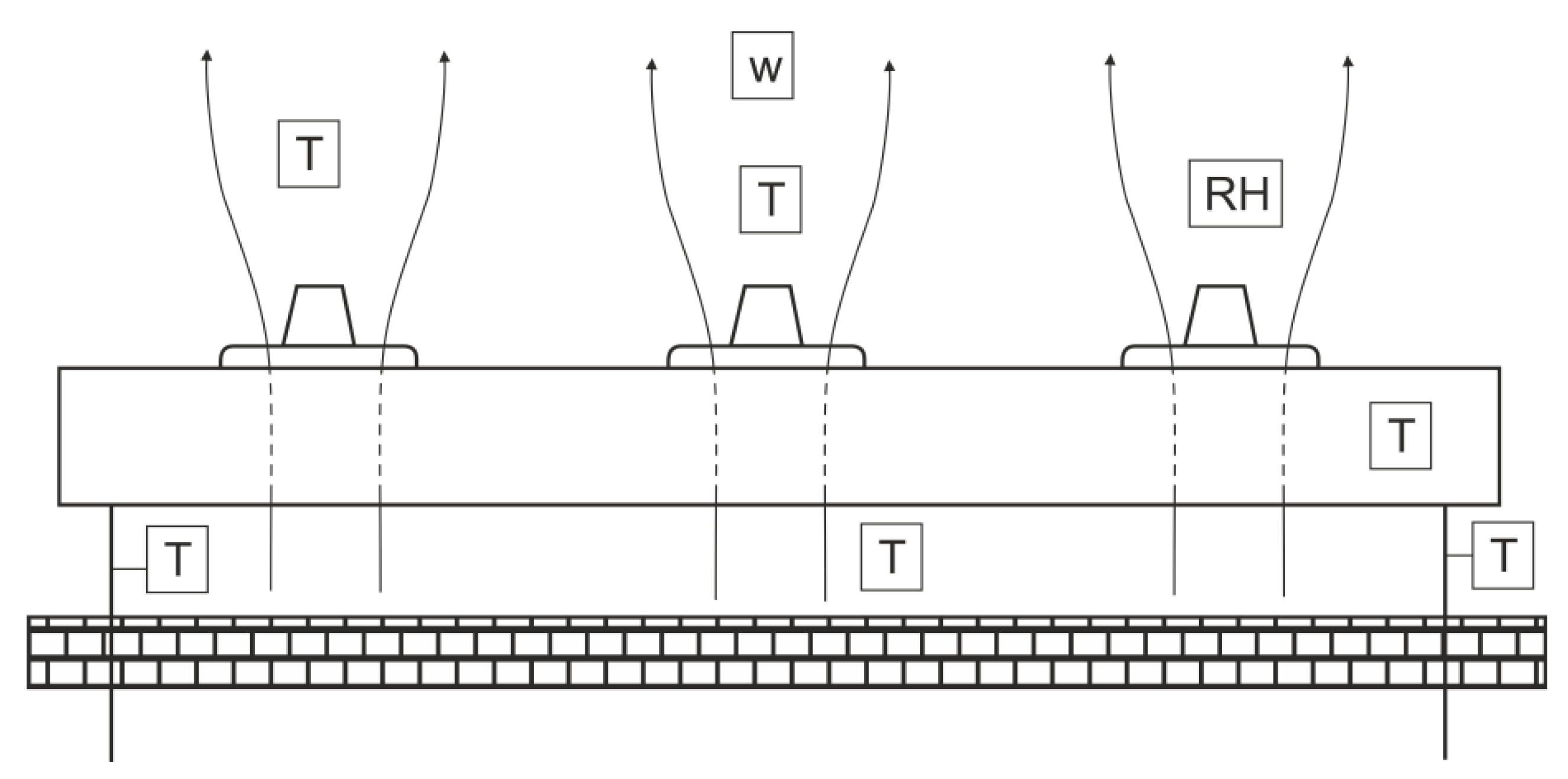


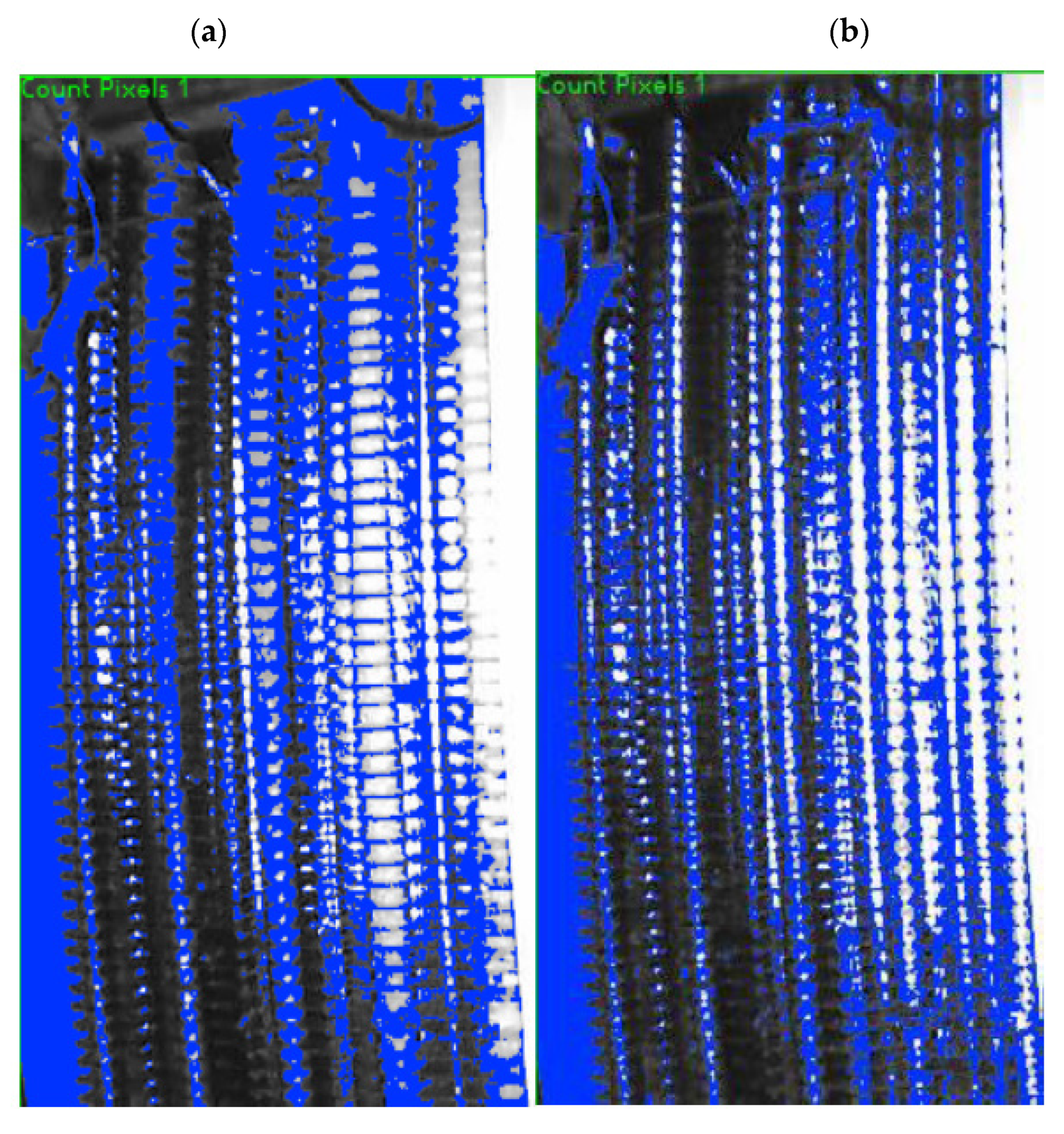
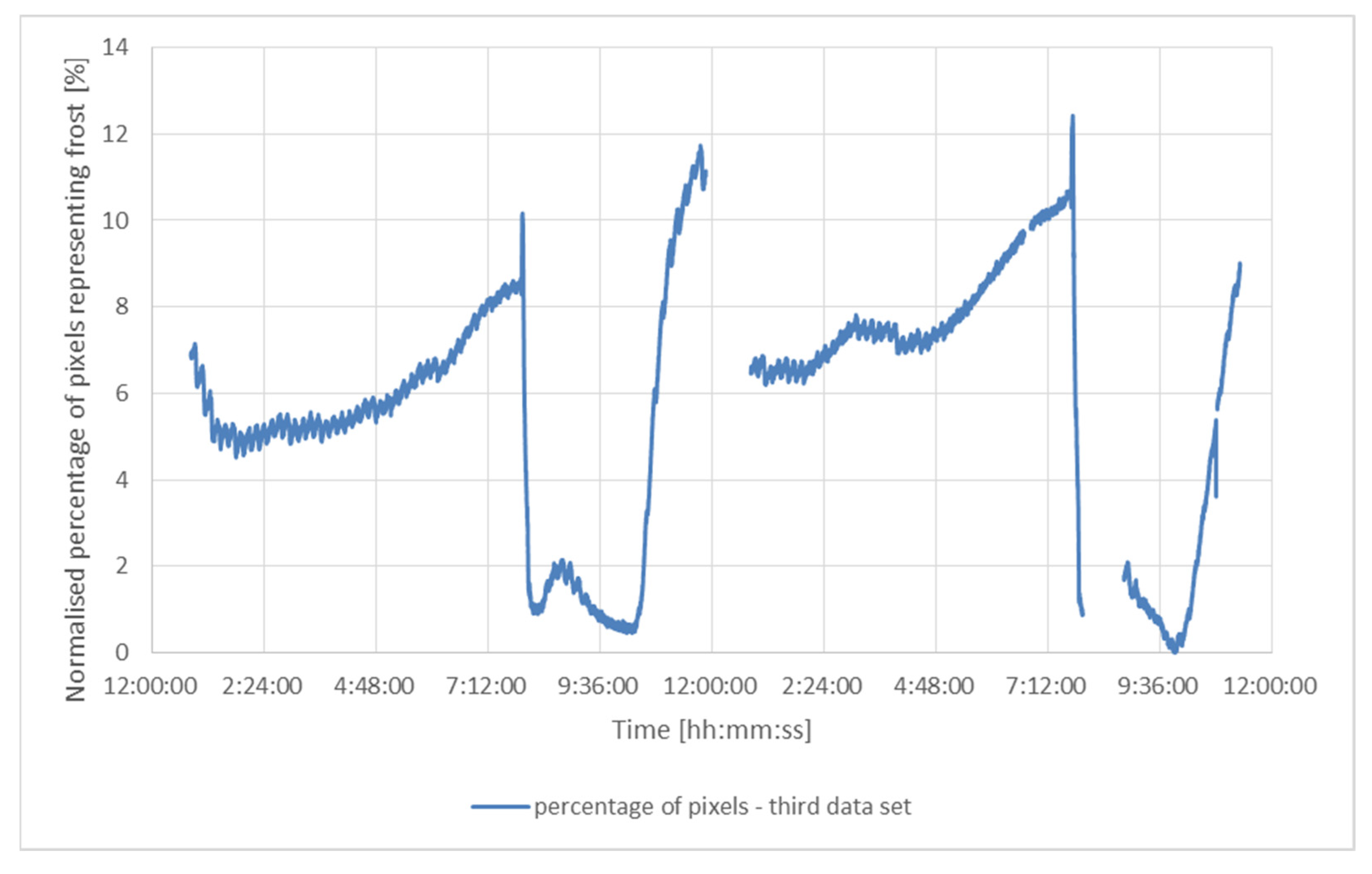

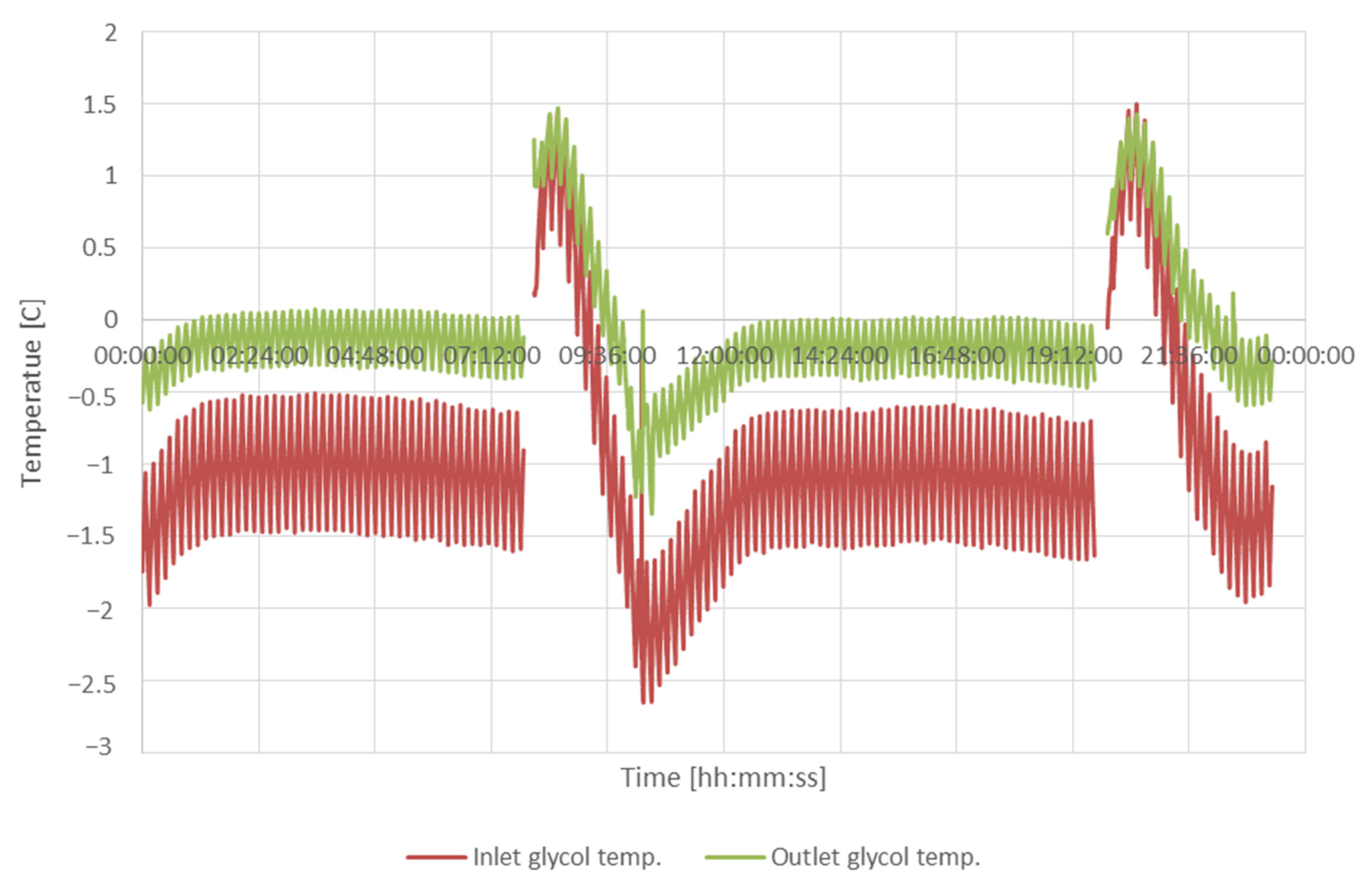
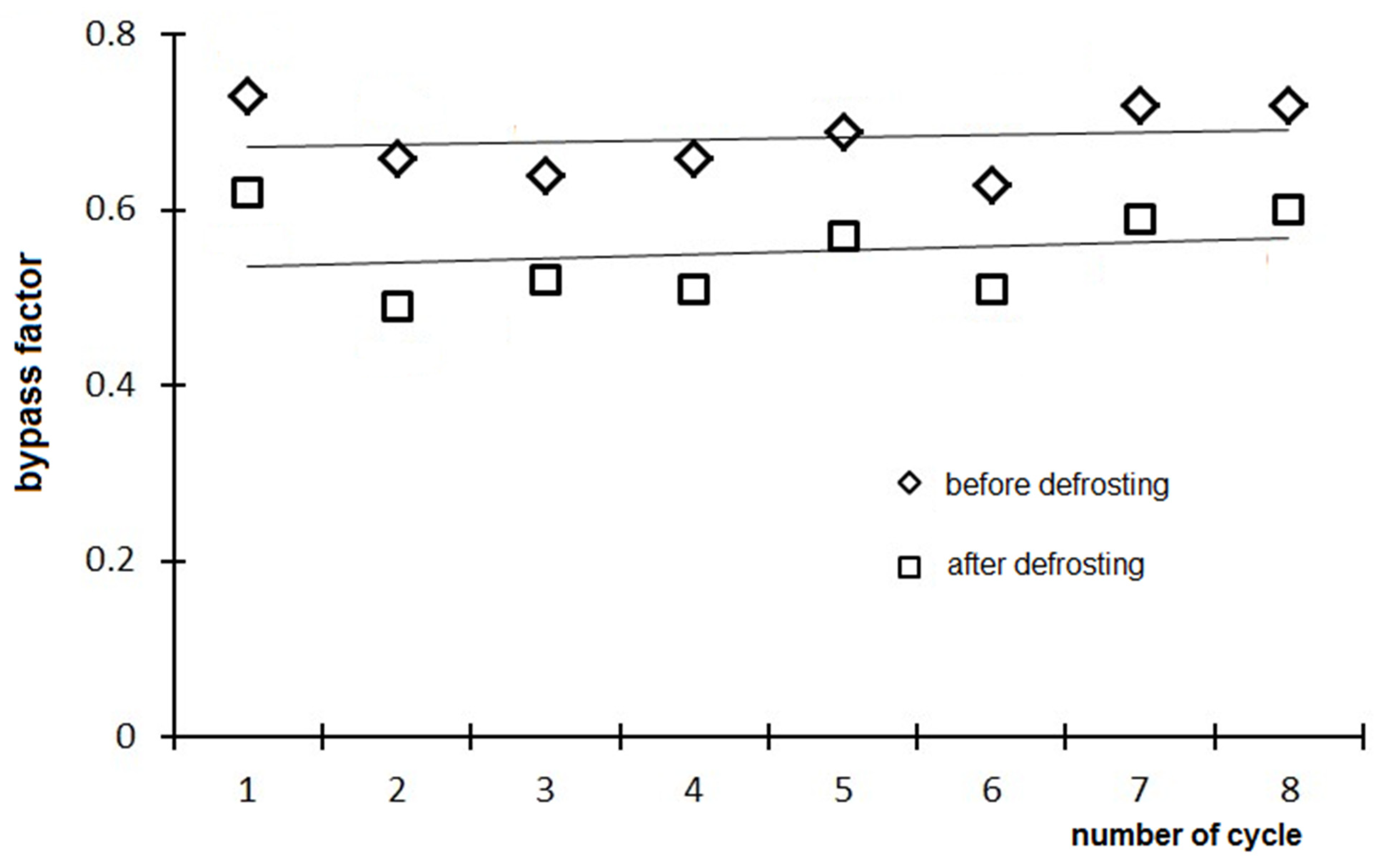
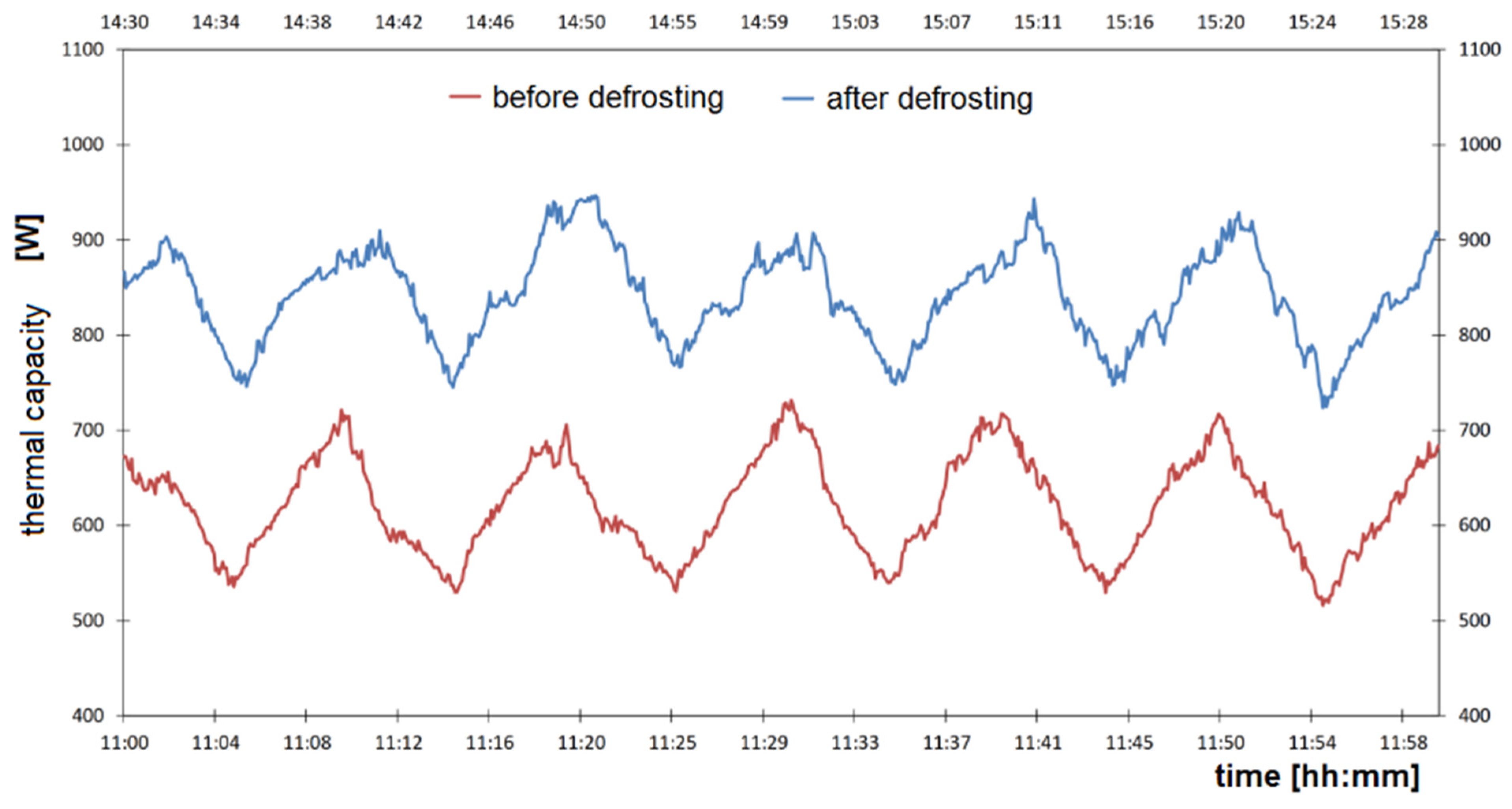
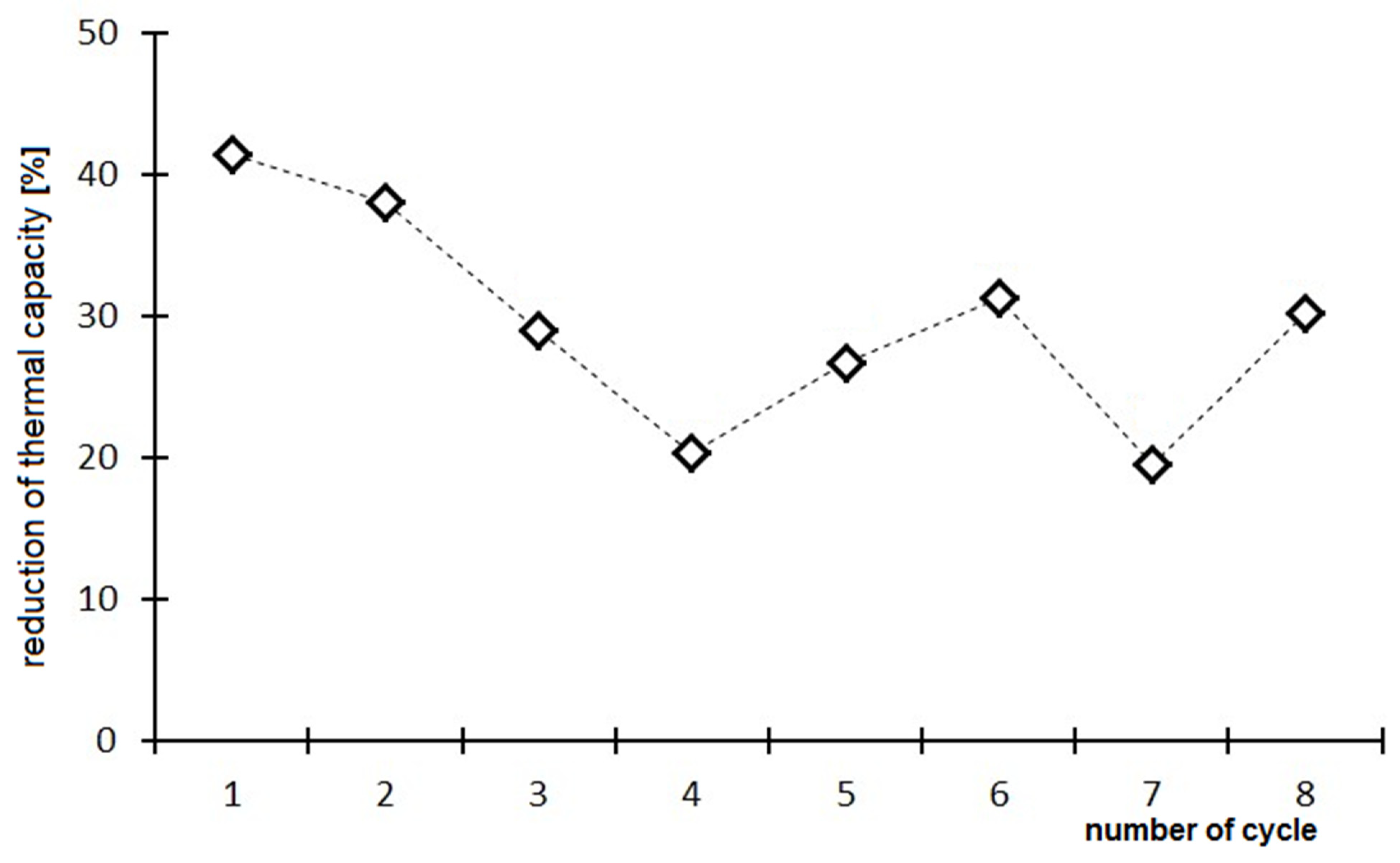


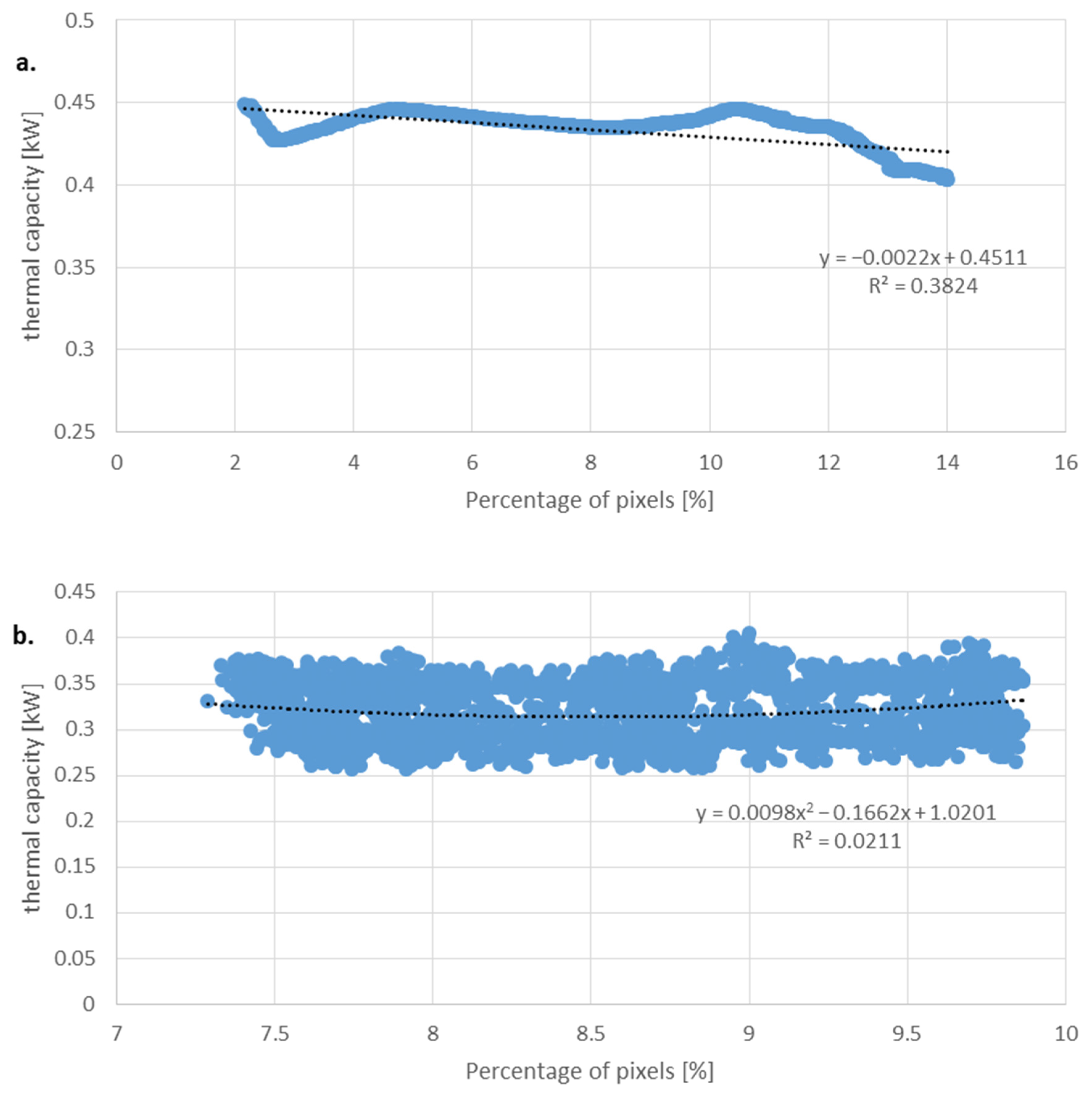
| Before Defrosting | After Defrosting | |||||
|---|---|---|---|---|---|---|
| [W] | kfr [W/(m2 K)] | BFfr | [W] | k [W/(m2 K)] | BF | ΔRfr [m2 K/W] |
| 145.8 | 18 | 0.73 | 249.2 | 31 | 0.62 | 0.08 |
| 155.3 | 12 | 0.66 | 250.9 | 19 | 0.49 | 0.13 |
| 153.2 | 12 | 0.64 | 215.8 | 17 | 0.52 | 0.20 |
| 170.6 | 12 | 0.66 | 214.3 | 15 | 0.51 | 0.32 |
| 181.1 | 12 | 0.69 | 247.1 | 17 | 0.57 | 0.22 |
| 153.2 | 11 | 0.63 | 223.2 | 17 | 0.51 | 0.18 |
| 223.1 | 13 | 0.72 | 277.6 | 16 | 0.59 | 0.31 |
| 247.8 | 21 | 0.72 | 355.2 | 30 | 0.60 | 0.11 |
Publisher’s Note: MDPI stays neutral with regard to jurisdictional claims in published maps and institutional affiliations. |
© 2022 by the authors. Licensee MDPI, Basel, Switzerland. This article is an open access article distributed under the terms and conditions of the Creative Commons Attribution (CC BY) license (https://creativecommons.org/licenses/by/4.0/).
Share and Cite
Jakończuk, P.; Śmierciew, K.; Gagan, J.; Butrymowicz, D. Image-Analysis-Based Approach for Identification of Air Cooler Heat Transfer Degradation during Frosting Process. Sustainability 2022, 14, 13731. https://doi.org/10.3390/su142113731
Jakończuk P, Śmierciew K, Gagan J, Butrymowicz D. Image-Analysis-Based Approach for Identification of Air Cooler Heat Transfer Degradation during Frosting Process. Sustainability. 2022; 14(21):13731. https://doi.org/10.3390/su142113731
Chicago/Turabian StyleJakończuk, Paweł, Kamil Śmierciew, Jerzy Gagan, and Dariusz Butrymowicz. 2022. "Image-Analysis-Based Approach for Identification of Air Cooler Heat Transfer Degradation during Frosting Process" Sustainability 14, no. 21: 13731. https://doi.org/10.3390/su142113731
APA StyleJakończuk, P., Śmierciew, K., Gagan, J., & Butrymowicz, D. (2022). Image-Analysis-Based Approach for Identification of Air Cooler Heat Transfer Degradation during Frosting Process. Sustainability, 14(21), 13731. https://doi.org/10.3390/su142113731







